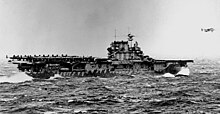USS Hornet (CV-8)
 The USS Hornet in late 1941 |
|
| Overview | |
|---|---|
| Shipyard | |
| Order | March 30, 1939 |
| Keel laying | September 25, 1939 |
| Launch | December 14, 1940 |
| 1. Period of service |
|
| Commissioning | October 20, 1941 |
| Whereabouts | sunk on October 27, 1942 |
| Technical specifications | |
| displacement |
25,600 tons l. (loaded) |
| length |
252.5 m |
| width |
33 m |
| Draft |
8.8 m (fully loaded) |
| crew |
2919 men |
| drive |
|
| speed |
32.5 knots |
| Range | |
| Armament |
|
| Planes |
80-90 |
The USS Hornet (CV-8) was an aircraft carrier for the US Navy . It was one of the Yorktown- class carriers and was used in the Pacific during World War II . It was from him that the bombers involved in the Doolittle Raid took off in 1942 .
history
The aircraft carrier was completed in Newport News , Virginia on December 14, 1940 and entered service on October 20, 1941. The first in command was Captain Marc A. Mitscher .
Calls
Doolittle Raid
On February 2, 1942, the Hornet left Norfolk harbor with two B-25 bombers on board. To the astonishment of the crew, the aircraft took off for a training mission on the high seas. Later this turned out to be a test for Operation Doolittle Raid .
Two months later, the Hornet set out for Japan with 16 B-25 bombers and 134 bomber crews to carry out a bomb attack on Japan ( Doolittle Raid ).
On April 11th, the L-8 airship was dispatched from San Francisco to bring 136 kg (300 lbs) of spare parts to the Hornet . They were needed for the B-25. The abseiling , freight required accurate maneuvering since almost the entire deck was delivered with the aircraft, which could not be brought under cover because of their size.
On April 13, the aircraft carrier teamed up with the USS Enterprise and Task Force 16 cruisers and destroyers in the Midway Islands . Originally the association was supposed to penetrate up to 400 nautical miles off the Japanese coast, but it was discovered and reported on April 18 by the Japanese patrol boat Nitto Maru . Therefore, Admiral William F. Halsey decided to launch Operation Doolittle Raid immediately.
Battle for Midway
In early June 1942, the Hornet played an important role in the victorious battle for Midway .
Battle of the Santa Cruz Islands
Your association cruised on October 26, 1942 at the Santa Cruz Islands to intercept the Japanese fleet. After the Japanese federation had successfully investigated it, it took off its 54 aircraft in two waves.
The Japanese, for their part, attacked the American unit with torpedo bombers and dive bombers. Warning messages reached the group too late. At 9:10 a.m. local time, the Hornet received its first bomb hit on the starboard side of the flight deck. Three minutes later, a Japanese plane crashing through the flight deck, which also carried three bombs, two of which detonated 50 kg each on the impact. Seven minutes later, another Japanese plane crashed into the forward gun battery on the port side and exploded. In both cases, it remained unclear whether the pilots - fatally hit - deliberately crashed their aircraft on the carrier or whether they were accidents in combat.
Attempts to tow the heavy cruiser Northampton failed because of the ongoing attacks by the Japanese. It was recognized that the ship could no longer be saved, as it was burning badly, and the order was given to the destroyer companions Mustin and Anderson to sink the ship. They shot nine torpedoes and about 300 shells of 127 mm caliber at the Hornet . This was not enough for the carrier to sink quickly, however, and the Hornet was then left to its fate. Ultimately, the Japanese destroyers Makigumo and Akigumo gave her the catch with four long-lance torpedoes . The USS Hornet sank off the Santa Cruz Islands on October 27, 1942 at around 1:35 a.m. local time. Most of the crew could be taken over by the escort ships and thus saved; Nevertheless, 111 men died and 108 were wounded.
The Hornet received four Battle Stars for its missions . Its sinking represents the last loss of a large fleet carrier in the US Navy so far.
wreck
In January 2019 it was announced that the deep-sea research vessel Petrel of the late Microsoft co-founder Paul Allen had found the wreck of the Hornet at a depth of 5400 meters near the Solomon Islands .
See also
Web links
- Website USS Hornet Museum (English)
- Picture gallery of the USS Hornet (English)
- The USS Hornet at navsource.org (English)
Individual evidence
- ↑ "Lost for 77 years: now wreckage of legendary US aircraft carrier has been found" Focus.de of February 13, 2019

